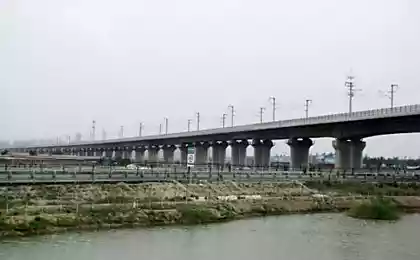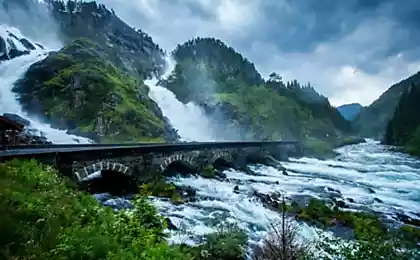1785
The most ambitious water bridges from around the world
Bridge - is the most complex piece of engineering, the design of which takes a long time. Let's look at the most difficult and, therefore, the most beautiful and unusual bridges from around the world.

It has long aqueducts were used to supply water to the city and to the 17th century, no one thought to use them for traffic. With the advent of modern canal systems began to appear and the relevant aqueducts, such as the channel on the river Loire, built in 1896. That he stayed the longest navigable aqueduct to the world of the 21st century, when it was built Magdeburg Water Bridge in Germany. In this article you will learn about the three most prominent channels of the world.

1. The Magdeburg Water Bridge.
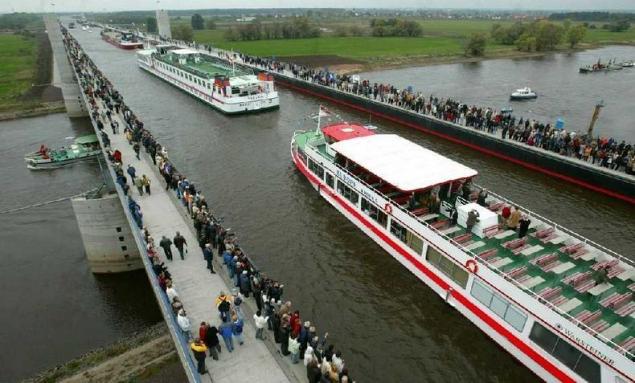
The bridge was opened in October 2003 and connects the Elbe-Havel with Mitteland, crossing the river Elbe. With a length of 918 meters - the longest navigable aqueduct in the world.
Previously, the Elbe-Havel and Mitteland occurred in Magdeburg, but on opposite sides of the Elbe River, which flowed significantly lower than the channels themselves. To move from one channel to the other ships had to make a detour of 12 kilometers, then spend an hour on the descent in a special elevator for boats to Elba, and then rise again to another channel, located above. Everything else, the low water level in the Elbe often prevented fully loaded barges passing through the channel successfully done this intersection. I had to spend quite a lot of time for loading and unloading goods.
After the reunification of Germany and the establishment of major trade routes of the country the construction of the water bridge has become the number one priority for the government.
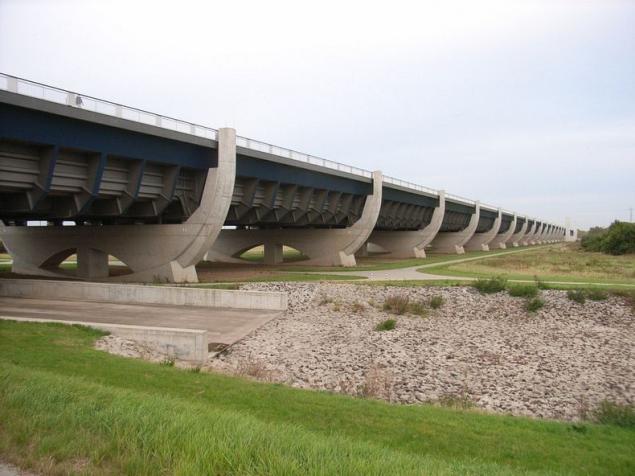
Work began in 1997 and construction took six years and cost 500 million euros. Water Bridge connects the internal network of channels in Germany to the ports along the Rhine River.

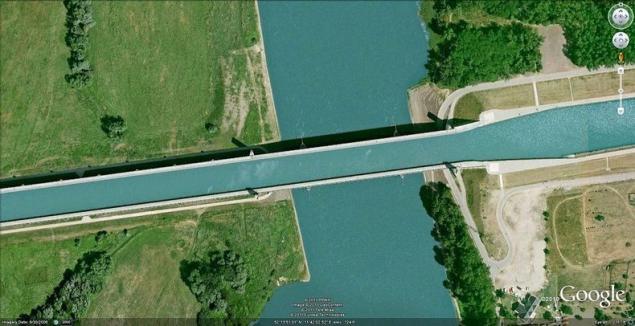
2. Pontcysyllte Aqueduct.

Pontcysyllte Aqueduct is located in Rekskheme, United Kingdom ... It was built between 1795 and 1805 year to bring the Ellesmere Canal over the valley of the River Dee. The main purpose of the construction was to link the coal mines Denbighshire to the national system of canals during the Industrial Revolution, when the country's economy is developing rapidly. Construction has been one of the greatest technical achievements of its time. For over 200 years Pontkisillte is the longest and highest aqueduct in Britain and currently belongs to the UNESCO World Heritage Site.

The length of the aqueduct is 307 meters, width - 3.4 meters, and reaches a depth of 1.60 meters. Pontkisillte is part of an aqueduct 18 kilometers long and is made of cast iron, supported by iron arched ribs strength at an altitude of 38 meters above the river. The ribs 19 abut the huge masonry piers. Using materials such as stone and iron allowed to create arches that look easy and elegant and at the same time having a very high strength.
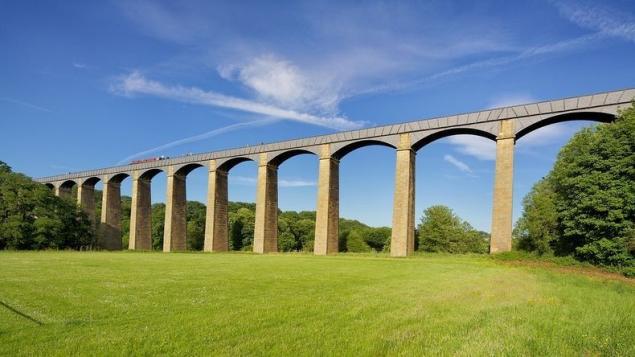


Economic impact on the development of the entire canal area was just enormous, especially in the first half of the 19th century. Increased production of coal, ore, limestone and lime production. Slate mountains and career of Welsh agriculture also learned a considerable benefit from the construction of the canal. Today it is no longer moved barges loaded with coal and ore - Aqueduct has become a popular tourist attraction. Since 1954 the channel operates and maintains its experts from British Waterways.

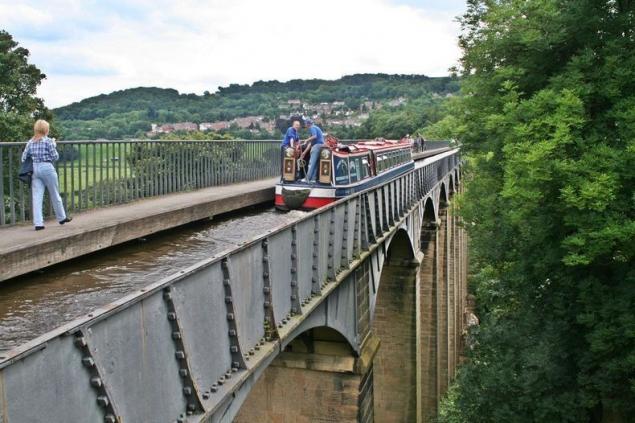

3. Barton Swing Aqueduct.

Barton Swing Aqueduct - a movable bridge water at Barton, in Greater Manchester, England. He carries the Bridgewater Canal, crossing the Manchester Ship Canal. His special device allows you to translate as small tour boats and large ships. This is the first and only moving the aqueduct in the world, which is considered a major feat of Victorian civil engineering.

Designed by Sir Edward Williams and built by Andrew Handyside, mobile aqueduct opened in 1894 and is still in regular use to this day. Previously there was located a stone aqueduct, which did not allow large ships to cross the river Irwell. Thus, Barton Swing was the only way to resolve this problem. Another outstanding construction of a water wheel Falkirk - a huge lift for boats.


In the photo below you can see the Swing Aqueduct in the closed position (left), as well as the Bridgewater Canal, which crosses the fairway. Barton Road Swing Bridge is located on the right:

Other notable water bridges are not included in this list of the top 3, you can select the Avon Aqueduct - the longest and highest in Scotland. It is also possible to add a selection of Briard aqueduct, which is included in the list of the most outstanding attractions of the UK.
It was the longest navigable aqueduct in the world before the opening of Magdeburg Water Bridge. As you already understood, most of such facilities in the UK, so if you want to explore all these wonders have to spend a lot of time, but eventually you will get a lot of positive impressions.
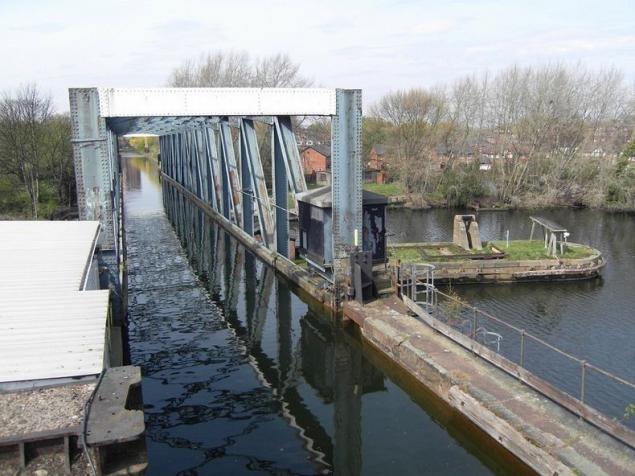
Source: asaratov.livejournal.com

It has long aqueducts were used to supply water to the city and to the 17th century, no one thought to use them for traffic. With the advent of modern canal systems began to appear and the relevant aqueducts, such as the channel on the river Loire, built in 1896. That he stayed the longest navigable aqueduct to the world of the 21st century, when it was built Magdeburg Water Bridge in Germany. In this article you will learn about the three most prominent channels of the world.

1. The Magdeburg Water Bridge.

The bridge was opened in October 2003 and connects the Elbe-Havel with Mitteland, crossing the river Elbe. With a length of 918 meters - the longest navigable aqueduct in the world.
Previously, the Elbe-Havel and Mitteland occurred in Magdeburg, but on opposite sides of the Elbe River, which flowed significantly lower than the channels themselves. To move from one channel to the other ships had to make a detour of 12 kilometers, then spend an hour on the descent in a special elevator for boats to Elba, and then rise again to another channel, located above. Everything else, the low water level in the Elbe often prevented fully loaded barges passing through the channel successfully done this intersection. I had to spend quite a lot of time for loading and unloading goods.
After the reunification of Germany and the establishment of major trade routes of the country the construction of the water bridge has become the number one priority for the government.

Work began in 1997 and construction took six years and cost 500 million euros. Water Bridge connects the internal network of channels in Germany to the ports along the Rhine River.


2. Pontcysyllte Aqueduct.

Pontcysyllte Aqueduct is located in Rekskheme, United Kingdom ... It was built between 1795 and 1805 year to bring the Ellesmere Canal over the valley of the River Dee. The main purpose of the construction was to link the coal mines Denbighshire to the national system of canals during the Industrial Revolution, when the country's economy is developing rapidly. Construction has been one of the greatest technical achievements of its time. For over 200 years Pontkisillte is the longest and highest aqueduct in Britain and currently belongs to the UNESCO World Heritage Site.

The length of the aqueduct is 307 meters, width - 3.4 meters, and reaches a depth of 1.60 meters. Pontkisillte is part of an aqueduct 18 kilometers long and is made of cast iron, supported by iron arched ribs strength at an altitude of 38 meters above the river. The ribs 19 abut the huge masonry piers. Using materials such as stone and iron allowed to create arches that look easy and elegant and at the same time having a very high strength.



Economic impact on the development of the entire canal area was just enormous, especially in the first half of the 19th century. Increased production of coal, ore, limestone and lime production. Slate mountains and career of Welsh agriculture also learned a considerable benefit from the construction of the canal. Today it is no longer moved barges loaded with coal and ore - Aqueduct has become a popular tourist attraction. Since 1954 the channel operates and maintains its experts from British Waterways.



3. Barton Swing Aqueduct.

Barton Swing Aqueduct - a movable bridge water at Barton, in Greater Manchester, England. He carries the Bridgewater Canal, crossing the Manchester Ship Canal. His special device allows you to translate as small tour boats and large ships. This is the first and only moving the aqueduct in the world, which is considered a major feat of Victorian civil engineering.

Designed by Sir Edward Williams and built by Andrew Handyside, mobile aqueduct opened in 1894 and is still in regular use to this day. Previously there was located a stone aqueduct, which did not allow large ships to cross the river Irwell. Thus, Barton Swing was the only way to resolve this problem. Another outstanding construction of a water wheel Falkirk - a huge lift for boats.


In the photo below you can see the Swing Aqueduct in the closed position (left), as well as the Bridgewater Canal, which crosses the fairway. Barton Road Swing Bridge is located on the right:

Other notable water bridges are not included in this list of the top 3, you can select the Avon Aqueduct - the longest and highest in Scotland. It is also possible to add a selection of Briard aqueduct, which is included in the list of the most outstanding attractions of the UK.
It was the longest navigable aqueduct in the world before the opening of Magdeburg Water Bridge. As you already understood, most of such facilities in the UK, so if you want to explore all these wonders have to spend a lot of time, but eventually you will get a lot of positive impressions.

Source: asaratov.livejournal.com






